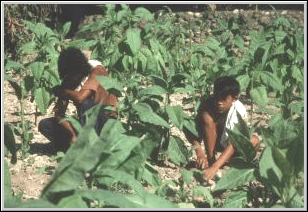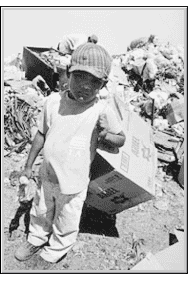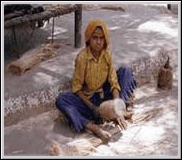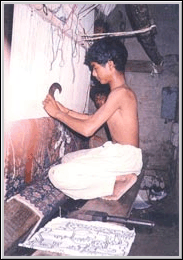 |
| MODULE 7: PSYCHOSOCIAL ISSUES AND OTHER MISCELLANEOUS
TOPICS IN OCCUPATIONAL AND ENVIRONMENTAL HEALTH SECTION 2: At RISK WORKING POPULATIONS: WOMEN AND CHILDREN: 2. CHILD LABOUR |
 |
| MODULE 7: PSYCHOSOCIAL ISSUES AND OTHER MISCELLANEOUS
TOPICS IN OCCUPATIONAL AND ENVIRONMENTAL HEALTH SECTION 2: At RISK WORKING POPULATIONS: WOMEN AND CHILDREN: 2. CHILD LABOUR |
Child labour is a major problem internationally, and as been such for centuries. Child labour on the British mines in the 17th and 18th centuries are well documented. Since these times social action has attempted to eradicate child labour.  The elimination of child labour has been on the agenda of international agencies, such as the ILO for a considerable period of time - commencing with a Minimum Age Convention in 1919, and currently over 132 countries have endorsed the international Convention on Child Labour (Convention 182 of 1999 - Worst Forms of Child Labour) - the most of any of the ILO’s Conventions. According to the statistics of the ILO, approximately 250 million children between the ages of 5 and 14 are employed in work. Most of these are in developing countries, employed in rural and agricultural settings. In some of these activities, a definite gender bias exists, with young girls predominating in activities.
The elimination of child labour has been on the agenda of international agencies, such as the ILO for a considerable period of time - commencing with a Minimum Age Convention in 1919, and currently over 132 countries have endorsed the international Convention on Child Labour (Convention 182 of 1999 - Worst Forms of Child Labour) - the most of any of the ILO’s Conventions. According to the statistics of the ILO, approximately 250 million children between the ages of 5 and 14 are employed in work. Most of these are in developing countries, employed in rural and agricultural settings. In some of these activities, a definite gender bias exists, with young girls predominating in activities.
There are a variety of reasons why children become economically active at a very early age, including a very much cheaper form of labour (or sometimes free labour, if for example, parents are farmworkers and living on the property, the child works for nothing for the farmowner), economic necessity in families in poor developing countries, need for fine motor skills in activities such as weaving, physical abuse such as child prostitution.
In cases were children work as a means to support their families - especially in low income countries, interesting challenges are thrown up, where from purely economic points of view, the concept of "the worst forms of hazardous child labour", becomes an important consideration. To remove children from this important support structure could have dire consequences, yet continued employment means exposure to major hazards resulting in ill-health and equally important, lack of access to opportunities for growth as a child and young adult - for example, access to education, social interaction etc, all of which perpetuates continued under development of such communities.
 |
The South African Department of Labour and Statistics South Africa recently compiled a detailed report on the "Survey of the activities of young people in South Africa" (DoL, 1999), and depending on the definitions used, approximately 45% (6.04 million) South African children aged between 5 and 17 were engaged in some form of work-related activities. Using a more stricter definition of more than 3 hours of work in economic activity, seven hours on household chores or five hours on school maintenance, then approximately 4.82 million children were engaged in work activity, of which more than 100 000 were working in agriculture and 26 000 in manufacturing sector. |
The UN defines child labour as "all forms of economic exploitation, any work that is likely to be hazardous or interfere with the child's physical, mental, spiritual, moral or social development", while the ILO defines it as "remunerated or unremunerated work by a young person under a certain age, the work of which impairs the young's personal development, health, safety, well being physically, mentally and psychologically, impairment of which is in violation of national or international law." The worst forms of child labour is considered to be the following:
 |
Although 70% of all children are employed in agriculture in rural areas particularly, the types of working environments differ in the urban areas. These are essentially in the informal sector (approximately 15%) with another 8% in activities such as trade and services. Very few children are employed in the formal sector. Activities in the informal sector include small-scale mining, brick-making, food processing, handicrafts making, carpet manufacturing or scavenging and rag picking in the dump-sites. When considering household chores, a significant number of children are involved in activities such as collecting wood or water. |
One very important consideration is the variety of hazardous exposures faced by child workers. Given that most are in sectors of the economy that is not well regulated, they are more than likely experiencing markedly elevated exposures. Occupational exposure limits, poorly defined in themselves, and rarely health based standards, are generally developed to reduce the risk in adults. These limits are completely untested among child populations. Because of the nature of these informal and poorly regulated sectors, children are also placed at physical risk - assaults and sexual abuse from older supervisors or managers, have poor access to sanitation or workplace hygiene, work with poorly designed worktools (normally designed for adult workers). Thus child workers face the full ambit of occupational injuries and diseases, particularly skin, respiratory and ergonomic disorders, similar to their adult counterparts, but at much higher level of risk.
Notwithstanding the health risks as a direct result of specific exposures, children experience additional effects:
|
 |
As mentioned earlier, the ILO established a Minimum Age Convention way back in 1919, and subsequently developed several others (the Minimum Age (Sea) Convention, 1920, the Minimum Age (Agriculture) Convention, 1921, the Minimum Age (Trimmers and Stokers) Convention, 1921, the Minimum Age (Non-Industrial Employment) Convention, 1932, the Minimum Age (Sea) Convention (Revised), 1936, the Minimum Age (Industry) Convention (Revised), 1937, the Minimum Age (Non-Industrial Employment) Convention (Revised), 1937, the Minimum Age (Fishermen) Convention, 1959, and the Minimum Age (Underground Work) Convention, 1965). In 1973 the ILO decided to establish a single instrument for all these different categories - the Minimum Age Convention, 138.
The latest Convention on the worst forms of child labour recognises that the process to eliminate ALL forms of child labour is linked to social and economic development in each country, and that by addressing the most hazardous forms of child labour, a coherent and well support international campaign can be waged.
The Department of Labour has embarked on a "National Child Labour Action Programme for South Africa" (DoL, October 2002). The key principles of this programme include engaging in social dialogue to identify forms of child labour that has to be eliminated, strive to include input from children, ensure that children's interests are paramount when determining policy, prioritise resources targetting the worst forms of child labour and identify the key stakeholders involved in these issues.
Policy initiatives have to address income generation programmes and economic incentives to families to ensure that children are not forced to work to support families. Regulation and enforcement has to ensure community participation and involvement of the children themselves.
 |
The struggle to eliminate child labour in its entirety is likely to be a long struggle, given the dimensions of the problem, factors beyond the control of developing economies, the impact of globalisation and the struggle for survival of the world's poor. Against this background it is necessary to consider some critical initiatives to address the problem, including the development of policy frameworks, regulatory mechanisms and addressing issues of poverty. As part of this process, identifying those forms of child labour that have a particularly significant negative impact on the health of the child (the "worst forms of child labour") have to be prioritised. |
The development of programmes of occupational health aimed at child workers working under such conditions become essential. While attempting to remove children from such work, programmes must also ensure the evaluation of the general health status of the child worker and assess health risks associated with the specific hazards, embark on programmes of education on the hazardous nature of such work to child workers, rehabilitation programmes for the child worker, both physical and psychological, with return to school programmes, as an example.